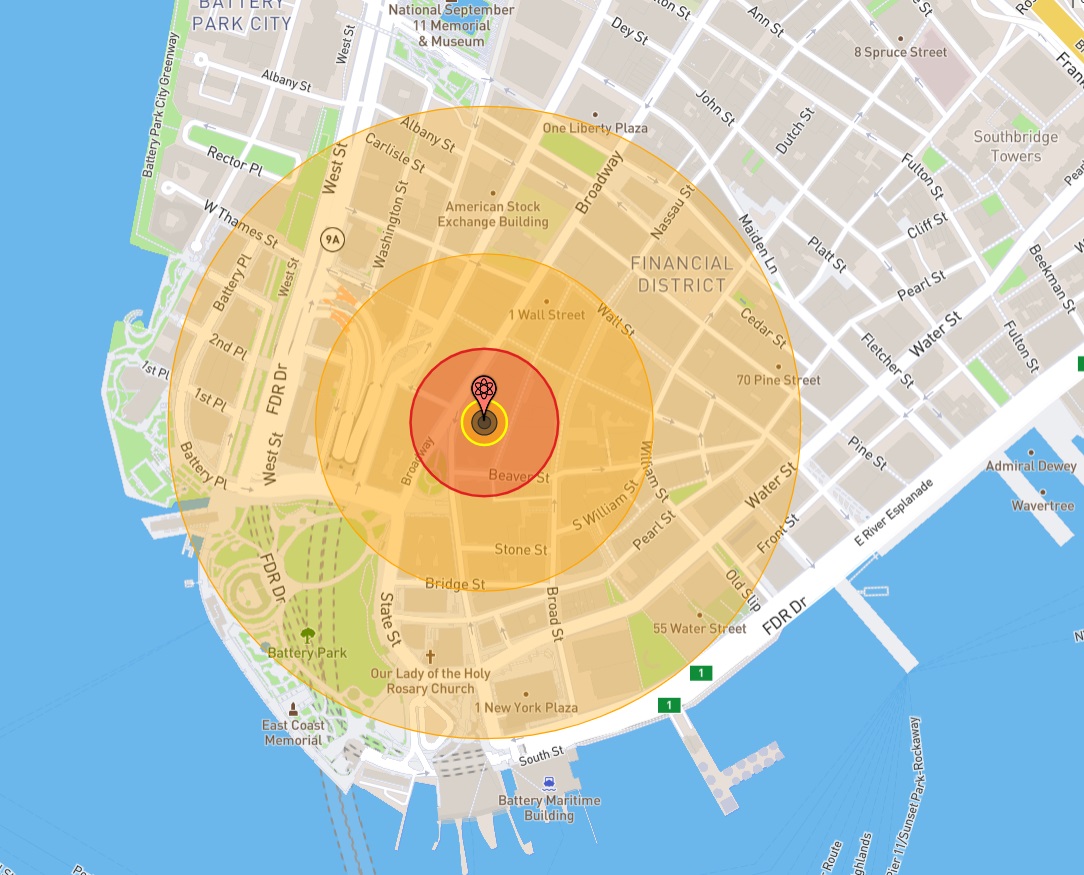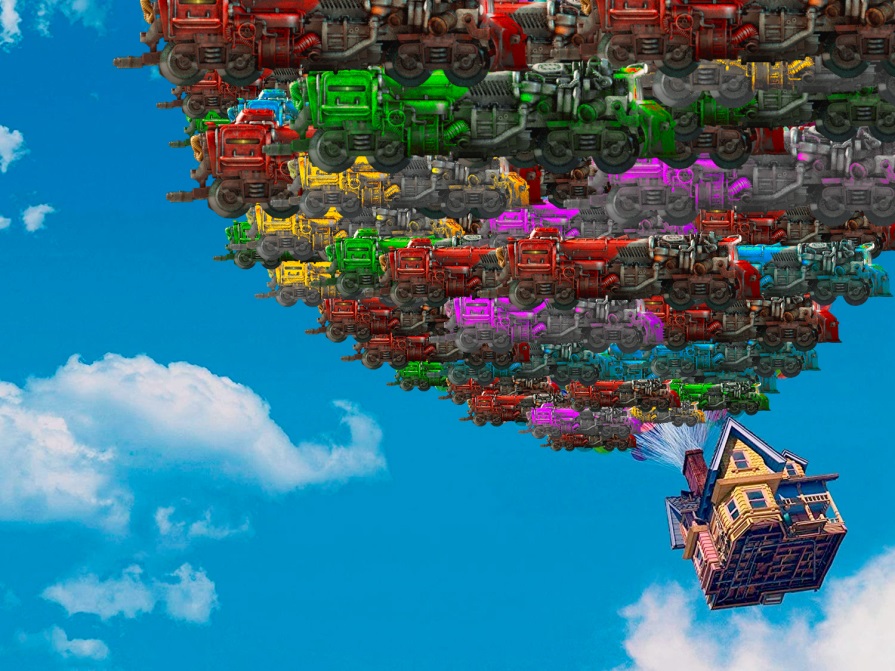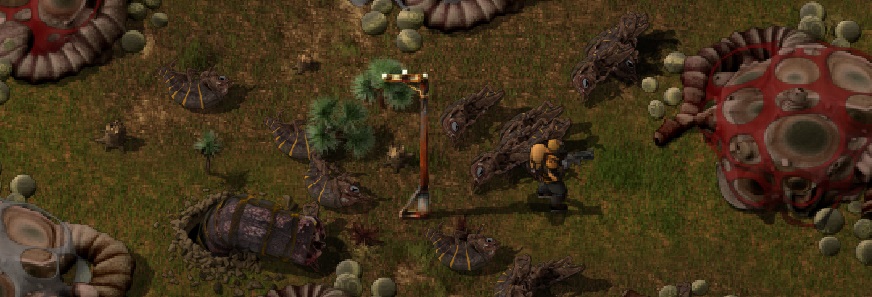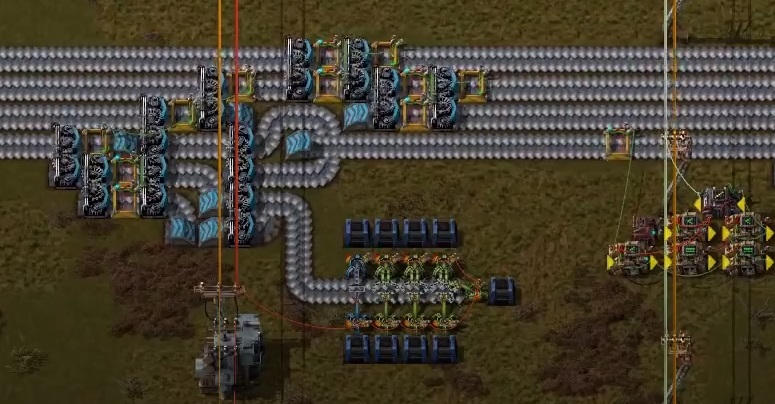Alt-F4 #11 - Scientific Curiosities 2020-10-30

Welcome to the eleventh edition of Alt-F4, bringing you both mathematical analysis and a history lesson. So, listen up, student! Pocarski took it upon themself to see whether real-world mathematics works out on Nauvis. Spoiler alert: it doesn’t. Then, stringweasel returns once again to take a look at a bit of history, this time focusing on past mechanics that are now long obsolete.
A scientific examination of the Factorio world pocarski
Suspension of disbelief is a well-known concept, which does not stop some of us from ignoring it completely. I recently saw a Reddit post about calculating the density of Nauvis, and that gave me the idea of making a just-for-fun compilation of all the ridiculous science that goes on in the Factorio universe. After all, this community has always been just a bunch of nerds with way too much free time, so why not indulge in some recreational nerdiness?
Obvious warning: This article contains excessive amounts of maths; if you have a crippling maths allergy, feel free to skip it.
Nauvis is a white dwarf
This is a retelling of the Reddit post by u/DaveMcW that I just mentioned. Note that this theory assumes Nauvis’s day/night cycle is actually caused by rotation, which is something I’ll be arguing against later on.
Large celestial bodies are held together by gravity and, for a planet to not get ripped apart by centrifugal force, gravity at the equator must be greater than centripetal force. Assuming a spherical planet, and using the equations for centripetal force and gravity, we can show that:
$ \frac{GMm}{r^2} > mr\omega^2 $, where $G$ is the gravitational constant, $r$ is planetary radius, $M$ is planetary mass, $\omega$ is planet’s angular speed, and $m$ is the mass of the object those forces are acting upon;
$ \frac{GM}{r^2} > r\omega^2 \quad\Rightarrow\quad GM > r^3\omega^2 $
$ \frac{4}{3}\pi r^3 = V \quad\Rightarrow\quad r^3 = \frac{3V}{4\pi} $, where $V$ is planetary volume;
$ GM > \frac{3V\omega^2}{4\pi} \quad\Rightarrow\quad G\frac{M}{V} > \frac{3\omega^2}{4\pi} $
$ \omega = \frac{2\pi}{T} \quad\Rightarrow\quad \frac{3\omega^2}{4\pi} = \frac{3\pi}{T^2};\quad \frac{M}{V} = \rho $, where $ \rho $ is planetary density;
$ \frac{G\rho}{3} > \frac{\pi}{T^2} \quad\Rightarrow\quad \rho > \frac{3\pi}{GT^2} $
We end up with an expression of density only through rotational period. Inputting the values for $ \pi $ and $G$, along with the period of Factorio’s day/night cycle (T = 25,000 ticks = 416.(6) seconds) we find:
$ \rho > 813,400 \mathrm{kg/m^3} $
Nauvis’s density has to be greater than 813,400 kg/m3. For comparison, steel’s density is 8,050 kg/m3, lead’s density is 11,350 kg/m3, and osmium metal, the densest substance on Earth, has a density of 22,570 kg/m3. 813,400 kg/m3 is such an extreme number that Nauvis must be a white dwarf star to be that dense. A white dwarf is what’s left after a small star dies and undergoes collapse, leaving a superheated remnant about the size of the Earth. White dwarves have surface temperatures from 8,000 K to 40,000 K. For comparison, the surface of the Sun is a bit under 6,000 K. Nauvis soil must be an exceptional heat insulator!
A bit about Nauvis’s orbital mechanics
Since all shadows remain a constant length and direction throughout the day we must conclude that the light source’s position in the sky doesn’t change, meaning Nauvis is tidally locked to its star. It follows that the day/night cycle we observe is caused by some object occluding the light. Based on the frequency of the nights, that object is probably in orbit around Nauvis, and it can’t be a moon since a moon large enough for such long nights would tidally lock Nauvis to itself. So, night must be caused by a cloud of debris in orbit of Nauvis — which also provides a reason for the Engineer crashing there in the first place: the ship hit some rock in orbit.
An alternative explanation for the day/night cycle, proposed by some, is that Nauvis’s parent star is a Cepheid variable, which is a type of star that varies in size, temperature, and brightness in a regular pattern. I personally think this is impossible since the luminosity variance is way too high, especially for such a short period.
Nauvis reflects at least 88.3% of all light that hits it
A single Factorio solar panel has an area of 9 m2 and produces 60 kW during daytime. From those numbers we find that the surface receives at least 6.(6) kW/m2 (compared to 1 kW/m2 for Earth). Considering Nauvis’s ambient temperature is 15 °C, and that it is tidally locked, we can use a slightly modified effective temperature formula:
$ T = \root{4}\of{\frac{1}{2}\frac{P(1-a)}{\sigma}} $, where $P$ is power received per unit area, $T$ is absolute surface temperature, $a$ is albedo (what we’re trying to find), and $\sigma$ is the Stefan-Boltzmann constant;
$ a = 1 - \frac{2\sigma T^4}{P} $
$ T = 15\mathrm{°C} = 288.15\mathrm{K} $
$ P = 6666.(6)\mathrm{W/m^2} $
$ a = 0.8827 $
Nauvis has to have an albedo of at least 0.883 to maintain 15 °C. This means it reflects at least 88.3% of the light that hits it. Since the efficiency of our solar panels is probably less than 100%, and Nauvis is probably not an ideal blackbody, the albedo is likely even higher.
As a comparison, the Moon has an albedo of 0.14 and the Earth has an albedo of 0.306. If the Moon had an albedo of 0.883, it would be 6.3 times brighter. If the Earth had an albedo of 0.883, it would have an average surface temperature of -88.5 °C.
Nukes are severely underpowered
Now it’s time to return from space and take a look at the artificial things. One piece of Factorio Uranium-235 can produce 10 fuel cells, each of which contains 8 GJ (let’s ignore the neighbour bonus). This means a single piece of U-235 has 80 GJ of fission energy in it, and since one nuke uses 30 pieces of U-235, with a 20% fission rate (which is what you get with boosted fission; something that is required for such a small nuke), it should have an explosive yield of 115 tons of TNT. That doesn’t sound like a lot, but just the explosion sprite itself would be 60 tiles across. Such a nuke would destroy everything completely in a 100 tile radius, would kill everything in a 250 tile radius, and would do damage in a 500 tile radius (based on Nukemap).
For comparison, the in-game nuke only does damage within less than a 40 tile radius, so that’s a 12.5x difference in area of effect.

The rings on this diagram denote, from smallest to largest:
- Crater and crater lip (scorch mark sprite)
- Fireball (explosion sprite)
- Heavy structure damage (the “destroy everything completely” zone)
- 100% probability of 3rd degree burns (the “kill everything” zone)
- 50% probability of first degree burns (the “do damage” zone)
To be completely honest, if we consider that the U-238 also contributes to a fuel cell’s total energy output we get a somewhat smaller nuke. It’s still ridiculous, but a bit less so.
Speaking of nuclear power…
Nuclear fuel is three times hotter than the surface of the Sun
Locomotives have a constant energy consumption of 600 kW, but better fuel makes them faster. This means higher-tier fuel increases the engine’s efficiency.
We can express power output through acceleration and speed:
$ P_u = \frac{dA}{dt} = \frac{Fds}{dt} = Fv = mav $, where $P_u$ is useful power output, $m$ is train’s mass, $a$ is train’s acceleration, and $v$ is train’s top speed.
Let $N$ be efficiency:
$ N = \frac{P_u}{P_c} = \frac{mav}{P_c} $, where $P_c$ is total consumed power (600 kW);
$ \frac{N_1}{N_0} = \frac{a_1v_1}{a_0v_0} $, where $N_0$, $a_0$, and $v_0$ are correspondingly efficiency, acceleration and top speed when running on coal; $N_1$, $a_1$, and $v_1$ are the same parameters when running on a given fuel.
So, fuel efficiency divided by coal efficiency is exactly equal to new top speed times new acceleration, meaning nuclear fuel is $1.15 \times 2.5 = 2.875$ times more efficient than coal. Since locomotives can run on any fuel, it’s safe to assume they use a heat engine. If this engine runs as efficiently as possible (based on a Carnot cycle), its efficiency is:
$ N = 1 - \frac{T_{c}}{T_{h}} $, where $T_c$ is absolute temperature of the cold part of the engine (288.15 K; ambient temperature), and $T_h$ is absolute temperature of the hot part of the engine (heated by fuel). It is reasonable to assume that on Nauvis coal burns at 165 °C (438.15 K), based on boiler steam temperature. This means efficiency of a train running on coal is:
$ N = 1 - \frac{288.15\mathrm{K}}{438.15\mathrm{K}} = 0.34 $
Efficiency of nuclear fuel is 2.875 times greater (see above), meaning it is equal to 0.98. This means that:
$ 1 - \frac{288.15\mathrm{K}}{T} = 0.98 $
$ T = \frac{288.15\mathrm{K}}{1-0.98} = 18297.525\mathrm{K} = 18024.375\mathrm{°C} $
Nuclear fuel thus has a temperature of over 18,000 °C. Funnily enough, if boiler steam was just 3.68 degrees hotter, nuclear fuel’s efficiency would become exactly 1. And if it went even a bit over 168.68 °C, physics would start breaking.
That’s not that big of an issue though, because everything is already broken without it. For example…
Items have unbelievably low densities
This part is based on u/Maouitippitytappin’s Reddit post about their journey to find scale in Factorio. To recap their post: by knowing the energy consumption of basic furnace-based iron smelting we can find the mass of a single iron plate, which turns out to be only around 40 grams. Similarly, one copper plate is about 65 grams. (Sources may vary; you might get different search results)
Knowing this we can calculate that the raw materials needed for a single locomotive weigh a measly 14.6 kg. Since the locomotive takes up a volume of about 24 m3 (assuming it’s 2 m high based on how it looks) it has a density of 0.6 kg/m3, which is about half as dense as air. This means that locomotives can be used as balloons!

Perhaps Nauvis really is spinning, and doing it fast enough for buoyancy to be acting downwards due to centrifugal force. This is a very good explanation as to how you can fit 240 locomotives in a 1 m3 chest; it’s because they’re probably collapsible. What it doesn’t explain, however, is how trains can take a turn with only a 12 meter radius while moving at just under 300 km/h without derailing. They should be experiencing almost 60 g of acceleration when turning at full speed:
$ a = \frac{v^2}{r} = \frac{(82.8\mathrm{m/s})^2}{12\mathrm{m}} = 571.32\mathrm{m/s^2} = 58.26g $
Since the rails are clearly not sloped, the trains must have rollercoaster wheels, holding onto the tracks from 3 sides. I personally really enjoy the thought of balloon rollercoaster trains zipping around at 300 km/h with an 18,000 °C engine, but perhaps that’s just me.
Nauvis Archives: Outdated Techniques stringweasel
Over the years, Factorio has changed significantly. New players, new mechanics, new developers, new strategies, etc. And as things change, some techniques for playing get left behind to make way for new and improved ways. Like long ago when Kerbals landed on Mun using only wings as landing gear, or Minecraft players built minecart boosters to propel their carts. There are old rituals and techniques that we no longer use in the modern age. I always find it interesting to look back and see what was done in the past, so that’s what we’ll investigate here.
Victory Poles
In the days before 0.13, biters were very scared of any structures you built. They did not even attempt to expand and create new nests near anything that was placed by a devious engineer. This resulted in a certain ritual being invented by the community: the placing of Victory Poles. You could simply place down any entity after clearing a native nest, typically something cheap like a wooden chest or electric pole, and that would keep the biters off your rightfully conquered land. There is a great video by NegativeRoot which explains this ritual. Ironically, after 0.13, when biters were no longer afraid of our structures a few unsuspecting engineers found biter nests inside their undefended bases!

Corner Compression Loss
Most won’t realise it, but the transport belt is the most complex entity in Factorio. Today it “just works” but it took years to smooth out all the bugs and headaches. Things like items getting stuck, inserters not picking up the last item on the belt, and requiring underground belts to increase your UPS. More infamous, but long forgotten, is the corner compression loss from before 0.12 and the techniques used to maintain 100% throughput.
Back then, belts would lose compression around corners because of how collisions were handled. At the time, items on belts were individual entities with collision boxes which caused them to bump into each other around corners unintentionally; today these items don’t have collision boxes at all. Even at that time players still wanted to build big of course, and so had to circumvent this compression loss. For smaller builds, ~100% compression was achieved by replacing the corner with a higher tier belt or using two splitters. But for bigger factories with large busses—where the belts were already of the highest tier—more complex designs were required. Typically, these designs were made by the legendary belt wizard MadZuri, to be implemented in ColonelWill’s crazy factories.
Long debates were had on what the behaviour around corners should be, even after compression loss was fixed in 0.12. Should the items move at a constant speed, as they do currently, meaning the inner items exit the corner first? Or should the inner lane move slower so that the inner and outer lanes remain synchronised around corners? This essentially came down to discussing realism vs. gameplay and, sometimes inadvertently, latency vs. throughput. Some just enjoyed all the videos that were posted of real-life production lines going around corners.
Transport belt mechanics is one of those things where, if it’s not perfect, everyone will notice something is off. But as soon as it works, it will go by almost unnoticed because of its intuitiveness and simplicity. This is because a good implementation needs to feel intuitive and hide the enormous complexity behind it with a simple interface. And as you know, today’s engineers don’t often comment on belt mechanics. Transport belts are easy to use and just make sense. This means that the Factorio team has truly succeeded in creating the ultimate transport belt implementation.
Manual Priority Splitters
Splitters only gained the ability to set a priority input/output in 0.16.17 (alongside the introduction of filtering). Before this, priority splitters had to be built using only wits, spaghetti, and a whole lot of circuits. This resulted in a period in 2016 when these designs were a hot topic in the community. Players like Steejo, raspi, canidae, and Captain Konzept, to name a few, quickly started in-depth research and thorough testing for the sake of the factory.

Building a priority splitter using the circuit network was not easy, especially at the time, but this did not stop our highly skilled community; they overcame numerous obstacles with vigour. For example, when reading a fully compressed belt it could show either 6 or 8 items apparently at random. Even worse, there is no way to differentiate a fully compressed belt from a backed up belt. In either case, the circuit network would still read 8 (or 6!) items on the belt. This resulted in various complicated designs, each with its own expertly implemented tricks and hacks to make it work. Captain Konzept made a great video explaining the various approaches of different players (and another video later comparing these designs to the new splitters with internal priority settings).
After a while, people realized that in most cases a complex priority splitter is not really required, and adequate balancing is arguably good enough. This mindset changed again after the upgraded splitters were released with 0.16.17. Either way, the point is that they succeeded in creating a manual priority splitter! However, this is not the only crazy thing the experts achieved using simple splitter mechanics.
Black Magic: Mechanical Splitter Filtering
As mentioned, pre-0.16.17 (or 0.16.16) splitters behaved differently and had no filter setting. This limitation did however not stop the community from abusing splitters to filter items anyway—this time without using circuits! It started with this post from SPolygon saying their splitter was not splitting correctly. As daniel34 explained, the splitter would choose which side an item would flow to based on item type too, not simply alternating after every item. This piqued the legendary XKnight’s curiosity who immediately came up with a few prototypes that abuse this mechanic. These designs seemed to verge on magic and even flabbergasted the developers! Roughly a year later, u/tzwaan rediscovered XKnight’s work, continued the research, and later showed it to the Reddit world, dubbing it a Black Magic item sorter.
It needs to be remembered that these splitters have no intended filtering capability. Still, experts in the community could achieve filtering by abusing their inherent mechanics. Back then, in 2016 and 2017, most of the community was obsessed with splitters—be it priority splitting or crazy black-magic filtering. And instead of complaining to the developers to add these mechanics as features, they worked together to solve these common problems simply by playing the game. In my opinion it’s a testament of how great the Factorio community can be and how dedicated and skilled some of our players are.
Contributing
As always, we’re looking for people that want to contribute to Alt-F4, be it by submitting an article or by helping with translation. If you have something interesting in mind that you want to share with the community in a polished way, this is the place to do it. If you’re not too sure about it we’ll gladly help by discussing content ideas and structure questions. If that sounds like something that’s up your alley, join the Discord to get started!